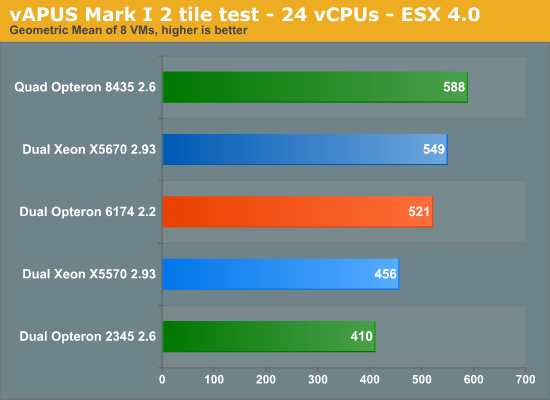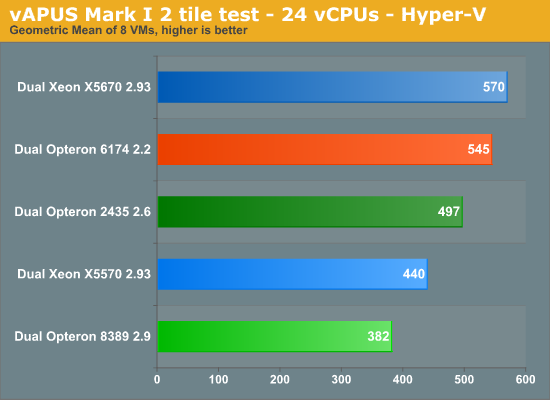AMD's 12-core "Magny-Cours" Opteron 6174 vs. Intel's 6-core Xeon
by Johan De Gelas on March 29, 2010 12:00 AM EST- Posted in
- IT Computing
vApus Mark I: Performance-Critical Applications Virtualized
Our vApus Mark I benchmark is not a VMmark replacement. It is meant to be complimentary: while VMmark uses runs 60 to 120 light loads, vApus Mark I runs 8 heavy VMs on 24 virtual CPUs (vCPUs). Our current vApus Stressclient is being improved to scale to much higher amount of vCPUs, but currently we limit the benchmark to 24 virtual CPUs.
A vApus Mark I tile consists of one OLTP, one OLAP and two heavy websites are combined in one tile. These are the kind of demanding applications that still got their own dedicated and natively running machine a year ago. vApus Mark I shows what will happen if you virtualize them. If you want to fully understand our benchmark methodology: vApus Mark I has been described in great detail here. We have changed only one thing compared to our original benchmarking: we used large pages as it is generally considered as a best practice (with RVI, EPT).
The current vApus Mark I uses two tiles. Per tile we have 4 VMs with 4 server applications:
- A SQL Server 2008 x64 database running on Windows 2008 64-bit, stress tested by our in-house developed vApus test (4 vCPUs).
- Two heavy duty MCS eFMS portals running PHP, IIS on Windows 2003 R2, stress tested by our in house developed vApus test (each 2 vCPUs).
- One OLTP database, based on Oracle 10G Calling Circle benchmark of Dominic Giles (4 vCPUs).
The beauty is that vApus (stress testing software developed by the Sizing Servers Lab) uses actions made by real people (as can be seen in logs) to stress test the VMs, not some benchmarking algorithm.
Update: We have noticed that the CPU load of Magny-cours is at 70-85%, while the Six-core "Istanbul" is running at 80-95%". As we have noted before, 24 cores is at the limit of our current benchmark until we launch vApus Mark 2. We have reason to believe that the opteron 6174 has quite a bit of headroom left. The results above are not wrong, but do not show the full potential of the 6174. We are checking the CPU load numbers of the six-core Xeon X5670 as we speak. Expect an update in the coming days.

The AMD Opteron 6174 performs well here, but disappoints a bit at the same time. vApus Mark I does not scale as well as VMmark. The reason is simple: as we used 4 virtual CPUs for both the OLTP as the OLAP virtual machine, scaling depends more on the individual applications. One VM with 4 virtual CPUs will not scale as well as 16 VMs sharing the same 4 virtual CPUs. Also, we use heavy database applications that typically like a decent amount of cache. The difference with the Xeon X5670 is small though. Servers based on both CPUs will make excellent virtualization platforms.
Next, the same test with Hyper-V, the hypervisor beneath Windows 2008 R2. We are testing with Hyper-V R2 6.1.7600.16385 (21st of July 2009).

Based on the excellent results of the Dual Opteron 2435 we expected AMD to take the crown in this benchmark, but that did not happen. We only had one week to get all of the Opteron testing done (AMD didn't have any hardware until the last minute), so we could not analyze this in depth. For some reason, the Opteron 6174 does not scale very well in our vApus benchmark. Compared to a 2.2GHz six-core, we only see a 30% increase in performance, about the same as Intel gets out of adding 2 extra cores to their Xeon. Part of the reason might be our benchmark: at the moment we are limited to 24 CPUs. We’ll investigate this in more detail in the coming quarter when vApus v2 is available.
The difference with the Xeon X5670 is small though, and the slightly lower price of the Opteron makes up for the slightly lower performance.










58 Comments
View All Comments
564265425722557 - Monday, March 29, 2010 - link
1. Why is the TDP of the 65W ACP Magny Cours the question mark? And are you sure the TDP of the 80W ACP ones 115W?2. The Intel systems have only 24GB ram against the 32GB ram on the 2S magny cours. That's why the 100GB database test favors the Magny cours by a large margin.
JohanAnandtech - Monday, March 29, 2010 - link
AMD told us the TDP values of the Magny-Cours at 80 and 105W ACP. The TDP values of the Lower power versions were not disclosed yet.And as we disclosed on the benchmark config page, none of the benches uses more than 20 GB. The vAPus mark I uses about 19 GB. The SQL Server uses much less. While the SQL server test has to scan through the complete index, it does access the complete 100 GB data. There absolutely no advantage for the Opterons there. We checked.
The fact that we spec the servers like that is a direct consequence of their memory channels (3 and 4). There is not much we can do about that.
Penti - Tuesday, March 30, 2010 - link
How about about 4P performance? It's cheap now and it's AMD whole selling point. I guess you can get a 4P 48-core 128GB system for not that much. How would that compare to a say 2P Nehalem 12-core 92GB? Wouldn't they cost about the same? Will it still be competitive against 8-core 2P Nehalem-EX? And how about the 4P (like 6-core versions) Nehalem-EX? How about the 8-core versions of 6100 series Opterons?elnexus - Wednesday, March 31, 2010 - link
In answer to cost:Compare our 2P Xeon 5600-series Workstation :http://elnexus.com/products.aspx?line_id=15514
with our 4P Opteron 6100-series Workstation: http://elnexus.com/products.aspx?line_id=15635
(I hope this isn't condemned as advertising, since it is an attempt to answer a question about price vs performance.)
Note how low priced the 6128 chip is (the default chip included in the base price).
AMD, I think are running away from Intel if you factor in the price...
Penti - Wednesday, March 31, 2010 - link
Thanks, I don't condemn it as advertising as this is a new platform so it's interesting and hard to get prices for complete systems yet. Basically 4P 8-core 6100-series opterons with 128GB DDR3 ECC REG cost as much as 2P six-core Xeon (Westmere EP) with 96GB DDR3 ECC REG. Mainly because you can use cheaper 4GB sticks and still get 128GB. And partly because there's no longer any markup for above >2P parts. I guess it accounts for something. Yeah, 6128 chip virtually don't cost nothing for being 4P compatible. Guess it helps AMD for a lot of workload scenarios. And since you can get 4P in 1U it's really nothing that speaks against it. Will be interesting to see what the Nehalem-EX can do though.TitanusComp - Wednesday, April 6, 2011 - link
You can really get a good idea by comparing this two products:48 Cores:
http://www.titanuscomputers.com/A400-AMD-Workstati...
24 Cores (Quad SLi Capable)
http://www.titanuscomputers.com/X450-Intel-High-Pe...
Now, things to consider, do you need CPU or GPU power?
duploxxx - Monday, March 29, 2010 - link
To make the whole benchmark complete I think you should ask some AMD Opteron 6136 from AMD to get a full review.duploxxx - Monday, March 29, 2010 - link
and add the 56xx 4core counterpart off courseJohanAnandtech - Tuesday, March 30, 2010 - link
We are working on it. Expect an update with new SKUs this month. I would say next week, but I would like to take some time to do some in depth analysis.Hacp - Monday, March 29, 2010 - link
Anand,I want to ask why are you biased against AMD? You should base your tests based on price. AMD is selling their 12 core for the price of an Intel 6 core. Compare apples to apples! Do a 12 core vs 6 core comparison and see who wins. Otherwise, you are doing a disservice.